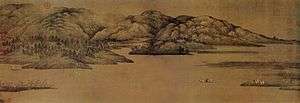Eight Views of Xiaoxiang

The Eight Views of Xiaoxiang (Chinese: 潇湘八景; pinyin: Xiāoxiāng Bājǐng) are beautiful scenes of the Xiaoxiang region, in what is now modern Hunan Province, China, as having been written in the poems, depicted in the pictures and known among the people, from the time of the Song Dynasty. The Eight Views of Xiaoxiang can refer either to various sets of paintings which have been done on this theme, the various verse series on the same theme, or to combinations of both. The Xiaoxiang theme should be viewed as part of a long poetic and artistic legacy.
Among the earliest extant artistic depiction of the Xiaoxiang region can be found in the renowned painter Dong Yuan's masterpiece Xiao and Xiang Rivers. The original set of eight painting titles were done by painter, poet, and government official Song Di (ca. 1067 – ca. 1080), during the reign of Shenzong, in the Song dynasty. A complete version of Song Di's Eight Views of Xiaoxiang has not survived.[1]
The eight scenes
- The rain at night on the Xiaoxiang (Chinese: 潇湘夜雨), in the south (Xiang River area)
- The wild geese coming home (平沙落雁), in Yongzhou
- The evening gong at Qingliang Temple (烟寺晚钟), in Hengyang
- The temple in the mountain (山市晴岚), in Xiangtan
- The snow in the evening (江天暮雪), on the Xiang River in Changsha
- The fishing village in the evening glow (渔村夕照), in Taoyuan County
- The moon in autumn on Dongting Lake (洞庭秋月)
- The sailing ship returning home (远浦归帆), in Xiangyin, in the north (of Hunan)
Symbolism

The Eight Views of Xiaoxiang is thematically part of a greater tradition. Generally, it is a theme that as artistically rendered in painting and poetry tends towards the expression of an underlying deep symbolism, such as exile and enlightenment. Furthermore, each scene generally expresses certain, sometimes subtle references. For instance Level Sand: Wild Geese Descend may refer to the historical exile of Qu Yuan in this region and to the poetry which he wrote about it. "Level Sand" may be seen as a reference to Qu Yuan because the Chinese character for level, Píng, was his given name (Yuan was a courtesy name). Furthermore, due to his having drown himself in one of the often sandy rivers of this region to protest his unjust exile, Qu Yuan was often referred to in poetry as "Embracing Sand", for instance by Li Bo. The wild goose is one of the hallmark symbols of Classical Chinese poetry, with various connotations: the descent of the goose or geese, combined with the descent to the level sand, signifies that the geese are flying south, the season is Autumn, and the forces of Yin are on the rise (thus adding to the involved symbolism).[2]
Influence

The Eight Views of Xiaoxiang inspired the people of Far East to create other Eight Views in China, Japan and Korea, as well as series of other numbers of scenes.
In China various versions of The Eight Views of Xiaoxiang have been inspired by the original series, as well as inspiring other series of eight scenes. The Eight Views of Xiaoxiang became a favorite theme of Buddhist monks.
Works covering the Eight Views include a set of paintings by Wang Hong (in the Princeton University Art Museum), now thought to be the earliest surviving depiction of the Eight Views,[3] a set of paintings attributed to Mu Qi (parts in the Kyoto National Museum),[4] and others.
See also
- Xiaoxiang
- Eight Views
- Eight Views of Taiwan
- Eight Views of Jinzhou (Dalian)
- Eight Views of Lushun South Road, Dalian
- Eight Views of Omi (近江八景 in Japanese), Japan
- Eight Views of Korea
- Geese in Chinese poetry
- List of National Treasures of Japan (paintings)
- Shōnan
- Thirty-six Views of Mount Fuji, series by Hokusai and Hiroshige
- Song Dynasty poetry
- Classical Chinese poetry
- Xiang River goddesses
- Xiaoxiang poetry
Notes
References
- Murck, Alfreda (2000). Poetry and Painting in Song China: The Subtle Art of Dissent. Harvard Univ Asia Center. ISBN 978-0-674-00782-6.
External links
- Eight Views of Xiaoxiang (in Chinese)
- Arts of Korea, an exhibition catalog from The Metropolitan Museum of Art Libraries (fully available online as PDF), which contains material on Eight Views of Xiaoxiang